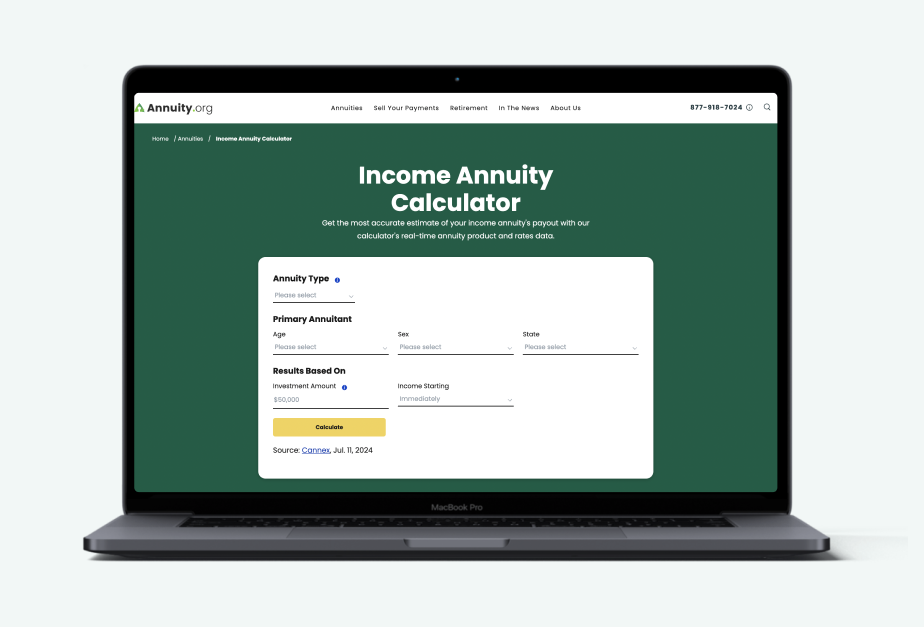When planning for retirement, understanding the difference between pensions and annuities is crucial for ensuring a steady income stream. While both provide regular payments, each has its unique features and benefits. Here are the key takeaways to help you grasp the differences and make an informed decision.
Key Facts About Annuities vs. Pensions
- Annuities and pensions both provide guaranteed income in retirement, but they are two different products.
- Pensions and annuities are different retirement income options. Pensions are typically funded by your employer, while annuities are insurance products you purchase.
- With a pension, you may receive a lump sum or an annuity, meaning you’ll receive regular payments for life.
Both pensions and annuities serve the purpose of providing reliable income, but the structure and flexibility of each vary. With this foundation in mind, we’ll next explore the different types of annuities to help you better navigate your retirement options.
What Are Pensions?
Pensions are an employment benefit and a way for a company to help workers finance their retirement. When you enroll in a pension plan, you’ll receive regular payments from your employer after you retire.
To qualify for a pension, employees must have a minimum number of working years. The plans pay out benefits based on the recipient’s age, health and experience as well as the company’s resources.
Employers who make monthly payments to former workers use pension funds that both the employer and employees paid into during the years the employee was working.
Some employers use their money to fund and control pensions. Others work with insurance companies to set up third-party annuities for employees, which provide security and relieve the company of the long-term financial obligation.
Most people no longer enjoy the benefits of a formal pension plan.
Since the early 2000s, the number of workplace pension programs has dwindled; many companies found it difficult to fund pensions over a long period of time while also pleasing shareholders who wanted more profits and fewer long-term liabilities.
The bulk of employers today with pension plans are federal, state and local governments, and branches of the U.S military. The government issues pensions in various forms, including defined benefit and defined contribution plans.
Pros and Cons
Pension plans can help provide stable sources of income in retirement, but they may not be accessible or appropriate for all retirees. It’s important to understand the pros and cons of any retirement plan.
Pros & Cons
Pros
- Guarantees a fixed payout in retirement
- Less investment risk than other retirement options
Cons
- No control over how money is invested
- Payments may not be adjusted for inflation
- Must stay with company for many years to receive benefits
Source: Corporate Finance Institute
Types of Plans
The two main types of pension plans are defined benefit plans and defined contribution plans. The former is what most people think of when they think of pensions.
Defined Benefit Plans
A defined benefit plan guarantees employees a specific monthly benefit after retirement. Sometimes this is a stated dollar amount, but more often the benefit is calculated based on your salary, age and how many years you worked at the company.
In a pension payout arrangement, the pension beneficiary does not have the option of taking control of this lump sum of funds, or has a say or choice as to how the funds are invested.
The monthly income from the pension payout simply serves as a contractually guaranteed lifetime monthly income.
The responsibility for funding and managing a defined benefit plan rests with the employer. The employer must ensure that there’s enough money in the pension fund to pay employees during retirement.
Defined Contribution Plan
The other type of pension plan is the defined contribution plan. With this plan, both the employer and the employee contribute to the pension fund. The benefit amount of a defined contribution plan is not guaranteed and can vary depending on how much money is in the pension fund and how the fund’s investments have performed over time.
How soon are you retiring?
What is your goal for purchasing an annuity?
Select all that apply
Average Pension Benefits
Pension benefits vary widely, often based on the type of employer, industry and location. According to data from the Pension Rights Center, only 30% of adults 65 and older received income from pensions in 2022.
- Federal Government Pension
- $26,380
- State or Local Government Pension
- $24,980
- Military Pension
- $24,130
- Veterans Benefits
- $15,630
- Private Pensions and Annuities
- $11,040
Median Annual Benefit
Source: Pension Rights Center
Investment returns on pension funds have trended downward since the start of the century — from more than 12% in 2000 to about 7% in 2021. The decline was blamed on a shift in fund investments from bonds to the more volatile stocks, according to a 2022 issue brief from the Pew Foundation.
Do you want a pension but your employer does not provide one? Annuities are a possible good alternative. Contact a qualified investment advisor to see whether an annuity works best for your investment goals.
Are Pensions the Same as Annuities?
Annuities bear many similarities to pension plans, but they are not the same thing. An annuity is an insurance product you can purchase through a provider rather than through your employer. When you purchase an annuity, your premium accumulates interest for a number of years before being converted into a stream of payments.
“Annuities and pensions share some similarities in that they both provide a stream of income in retirement,” said Michael D. Tschudy, a CFA Charterholder and the CEO of David Edward Business Solutions. “However, there are also some differences between annuities and pensions.”
Similarities of Annuities and Pensions
Both annuities and pensions are designed to give retirees a guaranteed source of income. You can choose how you’d like to receive your payments, with both annuities and pensions offering choices to receive a lump sum or a stream of payments.
Annuities and pensions both offer tax benefits, according to principal agent and founder of Insurance Geek Brad Cummins. “Pension contributions are often tax-deductible,” Cummins said, “while the earnings on annuities are tax-deferred until the funds are withdrawn.”
Differences of Annuities and Pensions
Despite their similarities, annuities and pensions are quite different products. A pension is a retirement benefit offered by an employer, while an annuity is a contract between a customer and an insurance company.
The funding for annuities and pensions is another key difference between the two. Pensions are funded by employers, sometimes with contributions from employees. Annuities are entirely funded by the person purchasing the annuity, usually with a large lump sum premium.
Because of how they are funded, annuities are much costlier than pensions. There are typically no costs associated with pensions unless employees make contributions, while annuities require not only an initial investment but also fees and extra charges depending on the product.
An annuity offers greater flexibility and portability than a pension. Cummins pointed out that annuities can be taken with you when you move from job to job, while a pension is typically tied to one employer.
Investment management is another feature annuities provide. When you purchase an annuity, you can choose to grow your premium at a fixed rate or tie it to the performance of a market index. You can even get a variable annuity that grows based on the performance of an investment portfolio you create.
As previously mentioned, pension funds are managed entirely by employers, so you can’t choose how the money in your pension is invested while you’re working.
The downside of managing your annuity’s investments is that you also assume the risk of getting less optimal payments if your investments underperform. “With a pension, the employer bears the investment risk and is responsible for ensuring there is enough money in the pension fund to make the payments,” Cummins said.
Pension Payment Options
Pension owners often hit a crossroads when they retire. Somewhere between ages 55 and 65, they’ll have to decide whether they want a lump sum payout, a series of payments or a combination of the two.
Most companies default to a series of pension payments, requiring the employee to opt out of the plan before retirement if they want to receive a lump sum.
Lump Sum Payments
If you elect to receive a lump sum from your pension, you may receive a check for the full amount or roll the total into an eligible tax-free or tax-deferred plan, such as an IRA.
Accepting a lump sum from your pension might be a good choice if you’re retiring early or are concerned about the stability of your pension fund. A recent Kiplinger article reported that almost a million working and retired Americans have pension plans that are in imminent danger of insolvency, and the risk of your pension fund running out of money increases the more years you spend in retirement.
Although pension plans are protected by the Pension Benefit Guaranty Corporation (PBGC), the corporation’s exposure to the money in pension funds far outstrips its available reserves. If the PBGC itself becomes insolvent, pension funds would not be fully covered.
For this reason, some pensioners prefer to receive a lump sum at the beginning of their retirement. This way, you’ll have full control over your pension assets and can use them as needed throughout your retirement.
Your personal circumstances might make a lump sum pension more advantageous. “If the individual has a shorter life expectancy or requires a large sum of money for an expense, such as paying off debt or purchasing a home,” Tschudy said, “a lump sum payment may be the better choice.”
“Additionally, if the individual has the ability to invest the lump sum payment and earn a higher rate of return than the pension’s payment, they may be better off taking the lump sum payment,” said Tschudy.
Pros and Cons of Lump Sum Pension Payouts
Pros
- Access money for large purchases
- Potential for putting cash towards high-yield investments
- Prevent payments from losing value because of inflation
Cons
- Money may not last long if spent all at once
- Financial illiteracy may lead to poor investment of funds and loss of capital over time
Annuity Payments
The most common way to receive your pension is through a life annuity. This means you’ll receive payments periodically for the rest of your life. Usually, payments are distributed monthly, but some plans may allow you to opt for a different payment schedule, such as quarterly payments.
Choosing annuity payments for your pension could make sense if you value stability and consistency in your retirement planning. You know exactly how much you will receive each month, so you can plan your retirement budget accordingly.
A pension annuity also keeps the responsibility of investment management with your pension administrator. If you choose a lump-sum payout, you’ll have to decide how best to manage that money, increasing the risk that you could lose some of your hard-earned money to unwise investment choices.
Some pension annuities include provisions for beneficiaries such as a spouse. You may be able to choose a joint and survivor payout plan that distributes monthly payments to your spouse or other beneficiary after your death.
Pros and Cons of Pension Annuity Payments
Pros
- Choosing an annuity provides security but less flexibility
- Guaranteed income for life
- Taxes spread out over time
Cons
- Equal monthly payments may not account for an increased cost of living
- Much of your pension is reliant on the financial health of your former employer’s pension fund
- Your investment may not be readily accessible because of surrender charges
Combination Payments
A few pension plans might provide a third payout option: combination payments. If your pension offers this option, you could receive part of your pension funds as a lump sum payment while still receiving monthly payments.
Combination payments have some advantages to pensioners. “This option can provide flexibility in retirement planning by allowing the individual to use the lump sum payment for expenses such as paying off debt or purchasing a home, while still receiving a guaranteed income stream for life,” said Tschudy.
Pros of Combination Pension Payments
- Balance immediate and future expenses
- Access a large portion of pension for medical bills or other needs
- Reliable income over time
By law, a pension plan must provide a lifetime annuity option that pays benefits until you die or until a surviving beneficiary passes away. Your plan may offer a lump sum option in lieu of, or in addition to, a life annuity.
Some questions to consider while deciding how to accept the pension include:
- How long will my spouse live? A lump sum may not last long enough if the pension recipient or their spouse has a high life expectancy.
- How much can I afford to lose? Those without other wealth may benefit the most from payments rather than lump sum.
- Can I skillfully invest the money? If you or your spouse is a savvy investor, taking a lump sum and investing it wisely could result in more accumulated wealth in the long run.

Worried About Your Retirement Savings?
Can You Sell Pension Payments & Lump Sum Advances?
Pension recipients may be able to find buyers offering a lump sum in exchange for future payments, but the transfer is not as simple as selling single premium annuities or structured settlements.
Many pension transfers are prohibited.
For example, federal law prohibits assigning military and civil service pensions, and the IRS code prohibits the sale of some private pensions. Both the Securities and Exchange Commission and the Financial Industry Regulatory Authority have alerted pensioners to be wary about accepting cash buyouts.
However, a select amount of funding companies will purchase pension payments in exchange for a lump sum. Companies that buy pensions refer to the practice as factoring or setting up mirrored pensions, pension income programs, pension advance, pension loans or secondary-market annuities.
Can I Buy an Annuity to Replace a Pension?
Annuities can effectively replace a pension, if you purchase the right annuity.
Annuities, either through an income rider or with a Single Premium Immediate Annuity (SPIA), are one of the best methods of providing a contractually guaranteed lifetime income, one that an individual or a couple cannot deplete by living too long and exhausting their assets.
The annuity will pay out a lifetime or joint lifetime income, helping to mitigate longevity risk.
Simply put, annuities can alleviate the problems of “living too long” and, if properly constructed with the assistance of a fiduciary advisor, of “living too short.”
In the event of an individual or a couple passing earlier than anticipated, it is important that the annuity is structured so that the assets within are passed to the contract holder’s selected beneficiaries, and not retained by the insurance company or financial institution.
Editor Anna Baluch contributed to this article.





